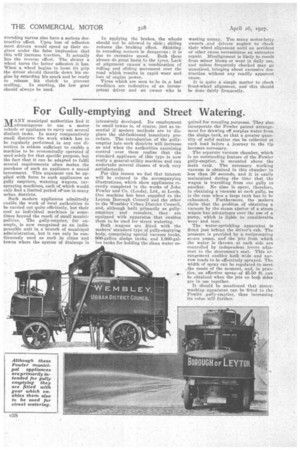For Gully emptying and Street Watering.
Page 60

If you've noticed an error in this article please click here to report it so we can fix it.
MANY municipal authorities find it 'advantageous to use a motor. vehicle or appliance to carry out several distinct tasks. In many comparatively small districts the work which has to be regularly performed in any one direction is seldom sufficient to enable a machine to be economically operated if used solely for that specific purpose, but the fact that it can be adapted to fulfil several requirements often makes the purchase of such an appliance a sound Investment. This argument can be applied with force to such appliances as gully emptiers, watering wagons, tarspraying machines, each of which would only find a limited period of•use in many urban districts.
Such modern appliances admittedly enable the work of local authorities to be carried out quite efficiently, but their cost as individual machines is sometimes beyond the reach of small municipalities. The gully-emptier, for example, is now recognized as an indispensable unit in a branch of municipal administration, but it can only be continuously used as such in cities and towns where the system of drainage is
intensively developed. Its employment in small towns is, of course, just as 'essential if modern methods are to displace the old-fashioned insanitary procedure. The introduction of the gullyemptier into such districts will increase as and when the authorities exercising control over them realize that the standard appliance of this type is now really a general-utility machine and can undertake several classes of work very satisfactorily.
For this reason we feel that interest will be evinced in the accompanying illustrations, which show appliances recently completed in the works of John Fowler and Co. (Leeds), Ltd., at Leeds. One machine has been supplied to the Leytou Borough Counciland the other to the "Wembley Urban District Council, and, although built primarily as gullyemptiers and resealers, they are equipped with apparatus that enables them to be used for street watering.
Both wagons are fitted with the makers' standard type of gully-emptying body, comprising special vacuum tanks, 900-gallon sludge tanks, and 1,000-gallon tanks for holding the clean water re quired for resealing purposes. They also incorporate the Fowler patent arrangement for drawing off surplus water from the sludge tank, SO that a greater quantity of solid matter can be collected at each load before a journey to the tip becomes necessary.
The separate vacuum chamber, which is an outstanding feature of the Fowler gully-emptier, is mounted above the main tank. The necessary working vacuum is obtained in this chamber in less than 30 seconds, and it is easily maintained during the time that the wagon is travelling from one gully to another. No time is spent, therefore, in obtaining a vacuum at each gully, as is the case when a large tank haste be exhausted. Furthermore, the makers claim that the problem of obtaining a vacuum by the steam ejector of a steam wagon has advantages over the use of a pump, which is liable to considerable wear and tear.
The water-sprinkling apparatus is fitted just behind the driver's cab. The pressure is provided by a reciprocating steam pump, and' the jets from which the water is thrown at each side are controlled by independent levers adjacent to the .steersman's seat. This arrangement enables both wide and narrow roads to be effectively sprayed. The width of spray can be regulated to meet ,the needs of the moment, and, in practice, an effective spray of 45-5G ft—can. be obtained when the jets on both sides arc in use together.
It should be mentioned that streetwashing apparatus can be fitted to the Fowler gully-emptier, thus increasing its value still further.












































































































